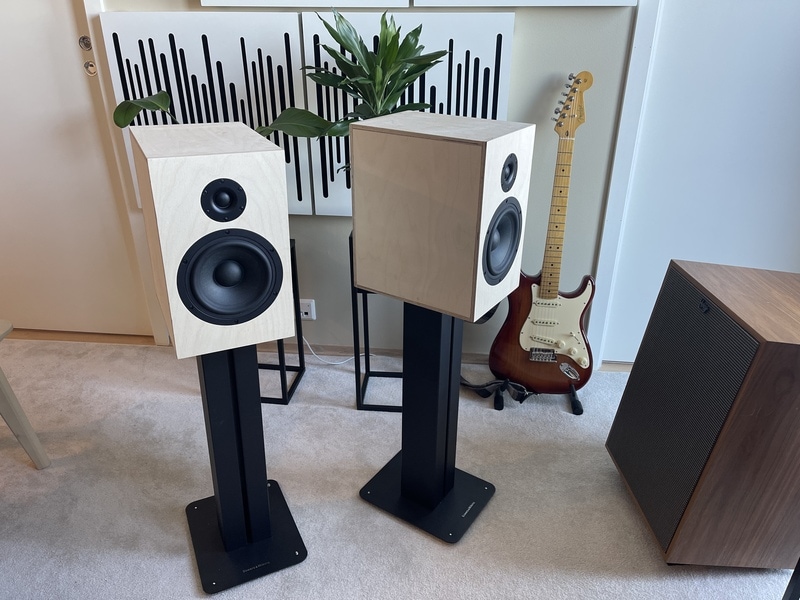
This is my review of the Criton 1TD-X speaker kit from Creative Sound Solutions, including in-room measurements and comparisons with Bowers & Wilkins 705S2 and the Klipsch Heresy IV.
Please don’t hesitate to send me an email if you have questions that are not answered in my review.
Key Takeaways
- Cabinet assembly easier than expected
- Crossover assembly slightly more tricky, but definitely doable
- The baltic birch cabinet option looks nice
- The tonality is as non-fatiguing and smooth as I was hoping for
- Instruments and vocals sound amazingly real
- Soundstage and imaging is very good – great instrument separation
- Deep bass, measures down to 26Hz in my room (-3dB)
- Needed to be placed 4 feet from front wall to avoid boomy bass in my room
- Noticeably lower sensitivity than my other bookshelf speakers
- Overall amazing value for money in my opinion – highly recommended
Intro and Background
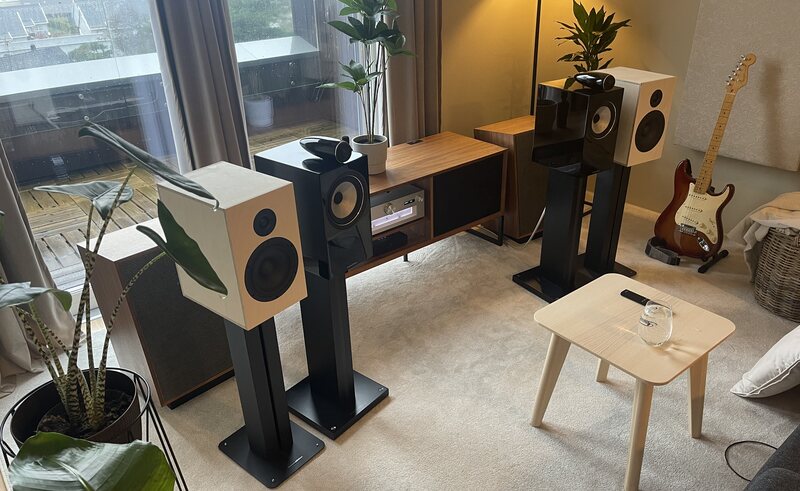
The further I get on my audiophile journey, the more I seem to be drawn towards speakers that sound pleasant and non-fatiguing.
When I got back into audio 5-6 years ago, I first got a pair of fairly analytical sounding Bowers and Wilkins 705S2. They are highly regarded speakers, but I never fell in love with their sound. I feel they are too analytical and “cold” sounding.
I then moved on to Klipsch Heresy IV about two years ago. They sound quite magical and were a huge step in the “right” direction for me. But probably still not super-soft on the ears. I love them, but I have never fully embraced them as my endgame speakers.
For my next, and hopefully, last speakers, I wanted something that is both genuine high-end performing and very low-fatiguing.
From research, I have found that speakers like Dynaudio Heritage Special and Sonus Faber Electa Amator might be great candidates for the sweet-sounding and high-end performing standmounts I am looking for.
Unfortunately, buying a new pair of Dynaudio Heritage Special and Sonus Faber Electa Amator would set me back $7,000 to $10,000 or something in that ballpark.
During online search for my endgame standmounts, I noticed several YouTube reviewers reporting that the Criton 1TD-X speaker kit from CSS Audio has a sound character and tonality that is in the same ballpark as the Dynaudio and Sonus Faber speakers mentioned above.
Not only that, they also suggested that the Critons deliver about 80% of their overall performance.
At only a fraction of the price.
I also welcomed the description of the Criton 1TD-X on the CSS website which describes their speakers as intentionally designed to be non-fatiguing.
I was quite intrigued.
The tradeoffs are, obviously, that I have to build the speakers myself and that the finished product will not be at a professional level aesthetically.
I figured I could live with those tradeoffs and decided to give the kit from CSS Audio a try.
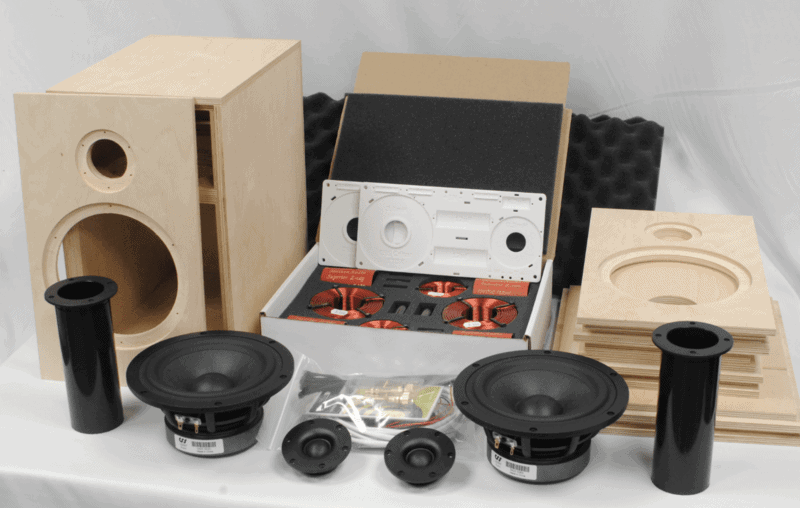
I ordered on the Criton 1TD-X kit with superior crossovers and the baltic birch flat pack.
So, I opted for the most premium version of the Criton 1TD kit available at the time. Since I had set a very high bar for the performance I was after, I decided to not compromise on the crossover parts. And I like the baltic birch cabinet option because it doesn’t really need veneering to look decent.
There is money to be saved if you choose the standard crossover and/or the MDF flatpack. You can also opt for the non-X CSS Criton 1TD version to save even more money, but I believe you start to sacrifice noteworthy performance at that point.
I bought the kit from Creative Sound Solutions with my own hard-earned money. I have not been sponsored by CSS in any way. I live in Europe so I had to pay about $250 in shipping and about $400 in value added tax so the total cost ended up at around $2100 in my case.
Criton 1TD-X Key Specifications
Below are the specification for the Criton 1TD-X copied from the CSS Audio homepage.
Crossover Point: 1600 Hz
Recommended Power: 20-100 watts
Nominal Impedance: 8 Ohm
Frequency Response:
+/- 2 dB from 45 Hz to 14 kHz anechoic
+/- 3 dB from 40 Hz to 20 kHz anechoic
30 Hz to 20 kHz in room
Sensitivity: 87 dB @ 2.83 V
Fb: 39 Hz
F3: 41 Hz
External Dimensions: 14″H x 8.5″W x 12″D
Cabinet Assembly
There are a few good videos on YouTube that show the process of building CSS speakers. I made sure I watched all of them thoroughly before I started on my own assembly, to have a good idea of what the process looks like.
I then did a few cabinet test-assemblies, simply putting together the cabinet profiles without glue to make sure I knew how everything fit together before the glue was applied. The assembly sequence is illustrated in the instructions that can be downloaded from the CSS website.
The flat-pack profiles snap together beautifully, these seems to be machined with quite high standards.
After a few pilot assemblies, it was finally time to glue the profiles together.
The wood-glue I used requires pressure to be applied for 30 minutes and then 24 hours to dry completely before maximum load could be applied. So relatively fast drying wood-glue I assume, not one of those that needs pressure for 24 hours.
I left the clamps on the first cabinet for about 90 minutes, not only 30 minutes, to be on the safe side, and then moved on to the second cabinet. So both cabinets were all done in abut two hours.
I used four big clamps and a fire extinguisher to apply pressure/weight to the cabinets. It wouldn’t have hurt to have a few more clamps, I think 4 is the absolute minimum.
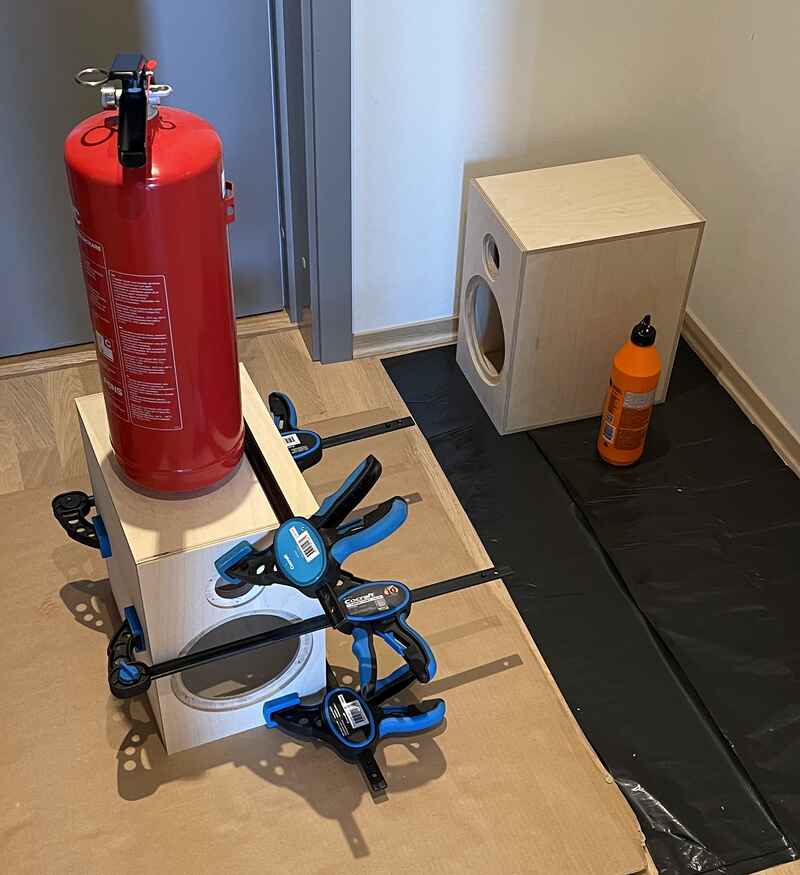
I have still not properly sanded and stained the cabinets so no first-hand experience with that process yet. I was too eager to get them up and running. I will go back and complete the finishing at a later stage. They already look ok but I assume spending a few hours sanding and staining will make them quit a bit nicer.
Overall, the cabinet assembly process went surprisingly smooth.
I am actually going through some major health issues at the moment, I’ve had a bad accident and haven’t been able to do much work for many months. So I was a bit concerned that I would not be able to put the speaker cabinets together when I bought them, but it thankfully worked out nicely.
Crossover Assembly
With the cabinet assembly completed, I got ready to assemble the crossovers.
I started the process by fitting all the parts on the included 3D printed crossover board and applied the zip ties to get everything securely fastened. One small frustration was that the 8 inch zip ties that came with the kit were not long enough to reach around the two biggest capacitors so I had to run out to get some 10 inch zip ties later.
With all the parts secured on the board, time to get the soldering iron going. I am actually an electronics engineer and have probably spent hundreds of hours with a soldering iron in my hand. But I haven’t worked as an engineer for about 15 years so I felt quite rusty when I blowed the dust off my old iron.
If you are not experienced at soldering, one tip is to practice on some spare wires or whatever before you start on the actual crossovers. Make sure to apply enough heat to the leads themselves so that the solder flows fluidly and spreads nice and deep into the whole connection point. The leads should be hot enough to melt the solder, just as the solder tip. If you only melt the solder with the tip, and try to somehow make it stick to the wires, you can easily get a cold or bad soldering that might not hold for long.
After I had completed soldering all the connections, including the few wire-jumpers that are required and the internal wires, I took my time to double and triple check that I had connected all the As, Bs, Cs, Gs and so on. I think one of the common mistakes is to overlook one of the ground connections – not connect all the Gs.
One minor challenge with the crossover assembly was to get all the connections on the back side of the board close enough to the board so that the board actually rest on its four feet, and not on the solder-points that stick out. The feet are quite short so it is somewhat tricky to get the wires and connections underneath close enough to the 3D printed board to make sure it rests properly on its feet.
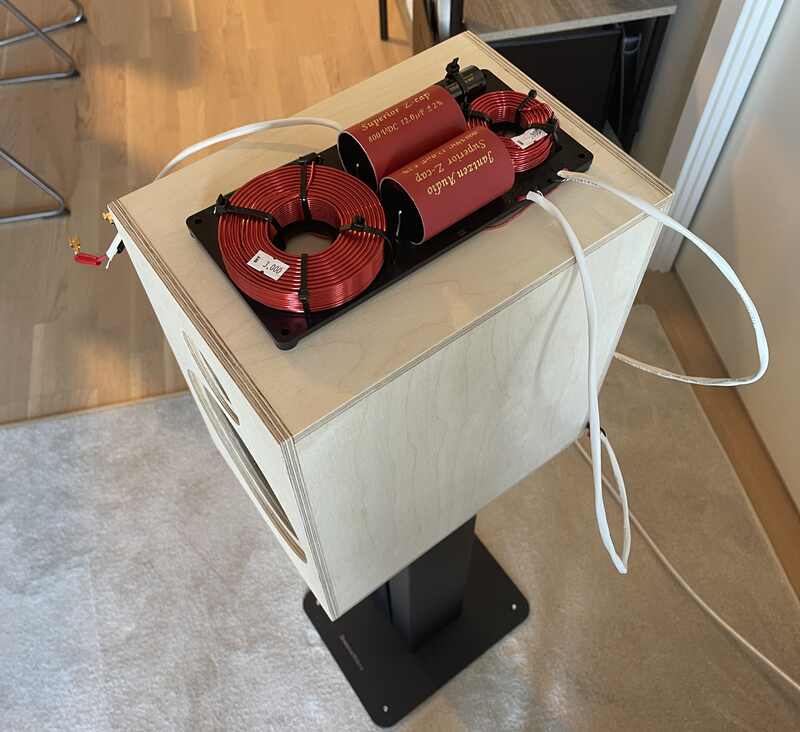
I think the crossover assembly process is manageable for most people. There are probably lots of “how to solder” videos you can check out on YouTube to get a grip on the correct soldering techniques. Just take your time and don’t plan to get this done in a hurry.
Final Assembly
The final assembly was reasonably straight forward.
Again, I made sure to look at the YouTube videos I could find as well as all relevant pictures I found using google search to get a good understanding of how everything should look inside the cabinets when completed.
I used a bit of tape to lock the adjustable port tube lengths at exactly 9 inches and fitted them to the cabinets.
I then mounted the binding posts. You might want to fit those before you glue the cabinets, it was slightly tricky to get them properly fastened working from inside the completed cabinets.
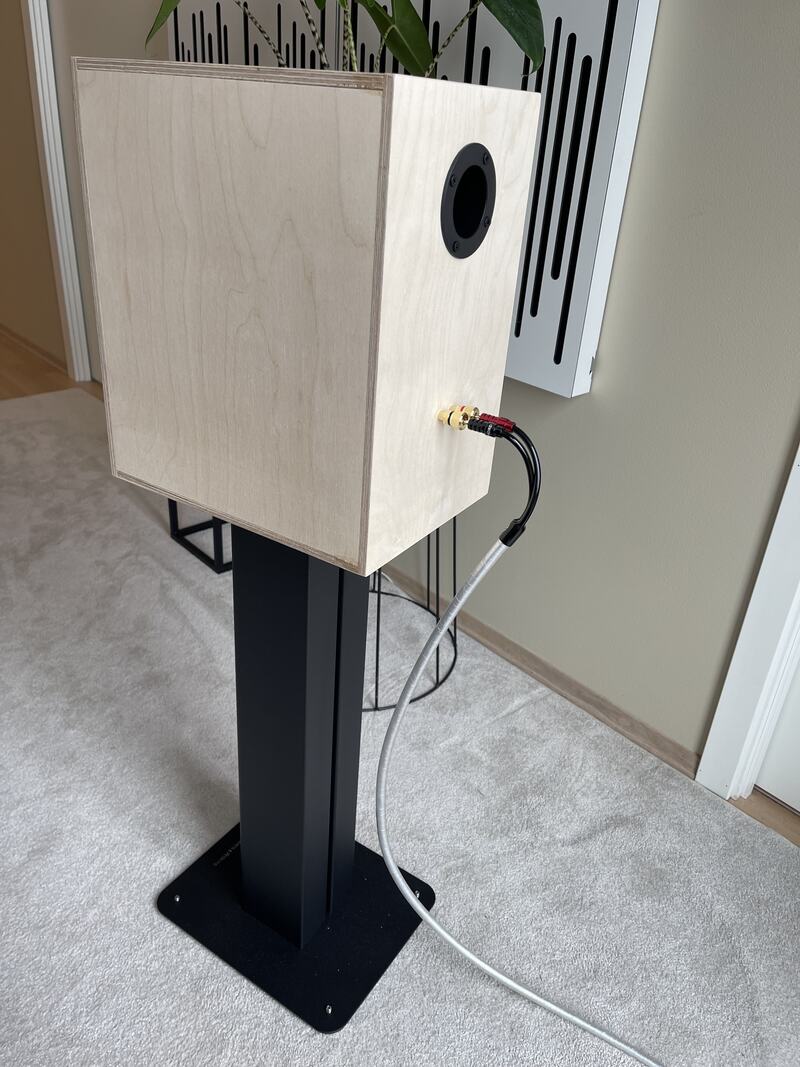
I then moved on to mount the crossover board to the bottom of the cabinet. Luckily, I had pre-drilled the holes for the screws before I glued the cabinets.
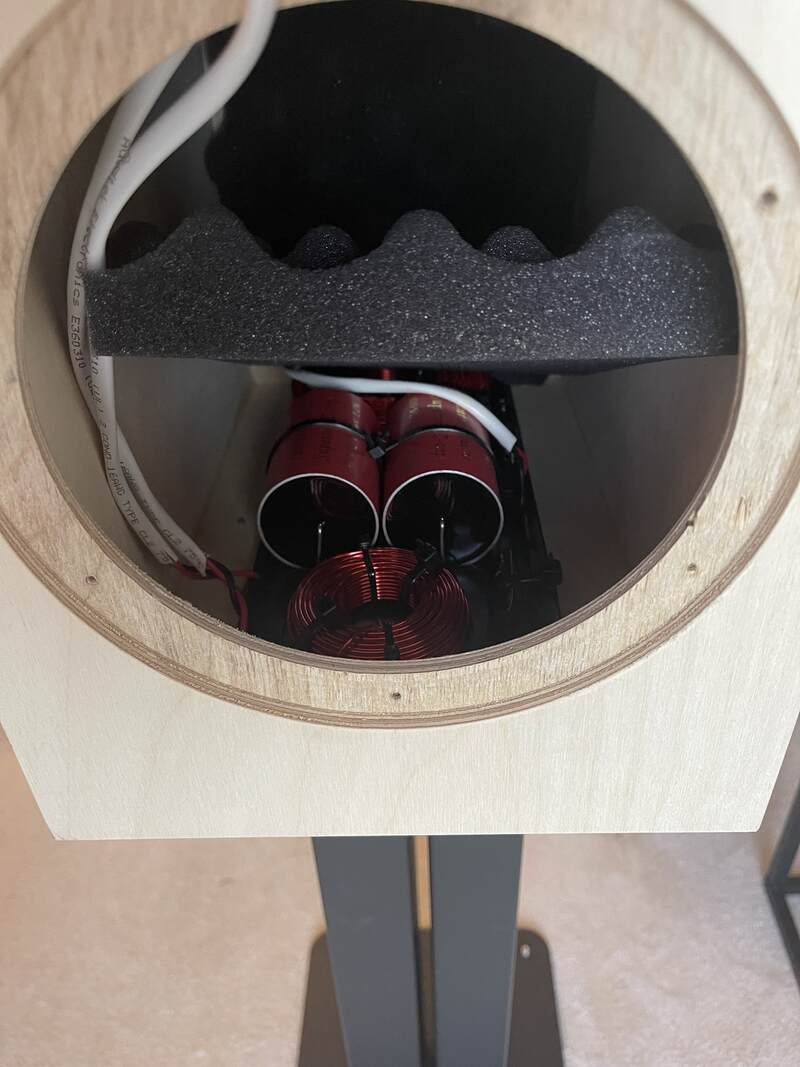
I then connect the binding post to the crossover, connected the tweeter to the crossover, fitted the tweeter, fitted the foam inside the cabinets, connected the woofer wire, and lastly, fitted the woofer.
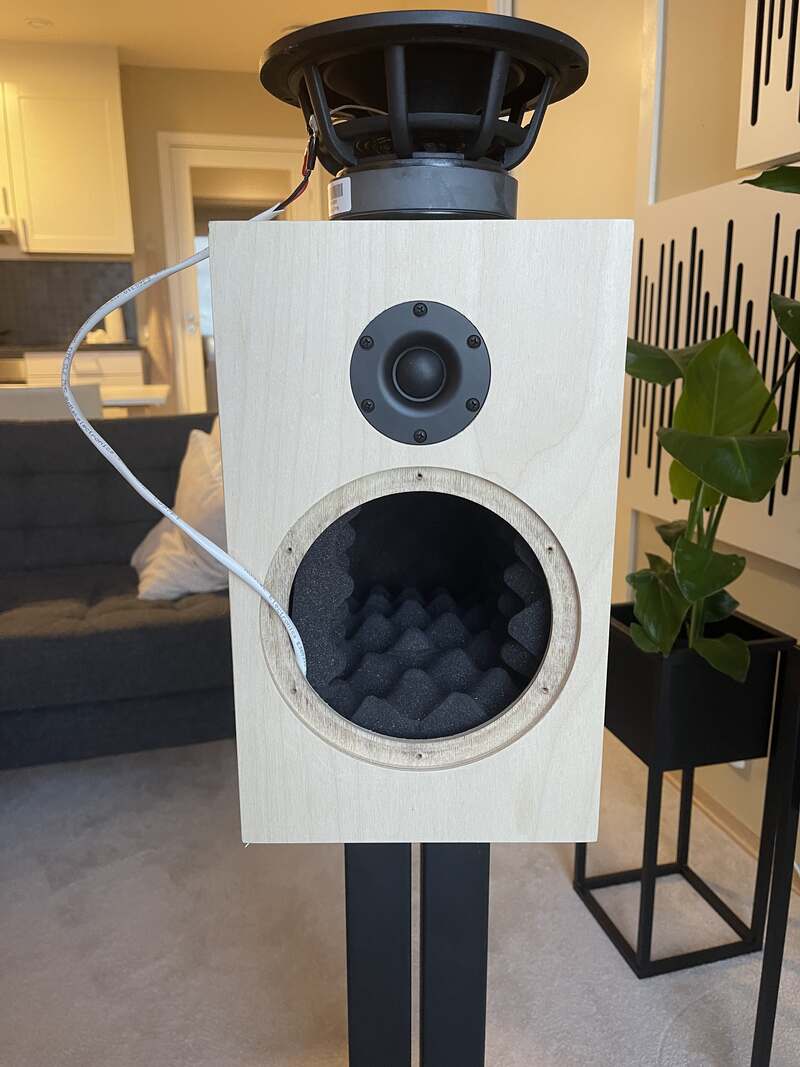
I did not find specific guidelines for how much foam to include in the cabinets, I guess that the amount of cabinet damping is somewhat down to personal preference. I decided to cut 4 pieces, one that covers the crossover, one for the back wall and two for the side walls. Doing that, I was using almost all the foam included in the kit, just a few small pieces were left over.
I screwed the finished cabinets to a pair of Bowers & Wilkins STAV24 speaker stands that cost about $250. I assume these are of fairly decent quality and I think they make the Critons look quite nice as their black finish matches the black drivers and form a nice contrast to the tan Baltic birch natural wood.
That was it, my first ever speakers build completed, time to put the Critons on song.
Equipment and Room
Before I move on with the listening test and measurements, please let me give a brief overview of my equipment and room for those interested.
I currently use a fairly detailed and neutral sounding $3000 Technics SU-G700M2 fully digital integrated amplifier. I bought it recently based on exceptional reviews across the board. I also love how it look with those big meters on the front.
It outputs 70 Watt in 8 ohms and doubles to 140 Watt in 4 ohms. From reviews, it seems to drive about every speakers out there without issues.
I had the CSS Critons in mind when I bought this amp, I thought they have a relaxed enough presentation to match up nicely with a quite detailed and natural sounding amp.
I use Tidal as streaming source and a BlueSound Node 2i streamer.
All my cables are of decent quality, but I don’t remember what they are…
My room is about 21 feet x 11 feet so somewhere between small and medium sized I assume.
The room has some acoustic treatment from Vicosutic and GIK and a RT60 “reverberation” time around 350ms which is considered close to optimal for 2-channel audio. It is not treated for the lowest frequencies tho, the amount of treatment needed for that is just not practical in this multi-usage room.
I use a miniDSP UMIK-1 USB mic for measurements and its standard calibration file from their website.
Initial Listening Test
Setup: Speakers about 1.5 feet from front wall, playing across my rectangular shaped room.
My room is multi-usage and I get the most out of it if I put the speakers and couch on the long walls and play across the room.
I know, it is usually recommended to set up the system to play lengthwise in the room, but I have gotten away with this across-the-room setup with my Klipsch Heresy IVs.
Although the speakers needs to go quite close to the front wall in this configuration, to obtain a reasonable distance between the speakers and listener, I have never notices any boomy bass issues with my Klipsch speakers positioned like this.
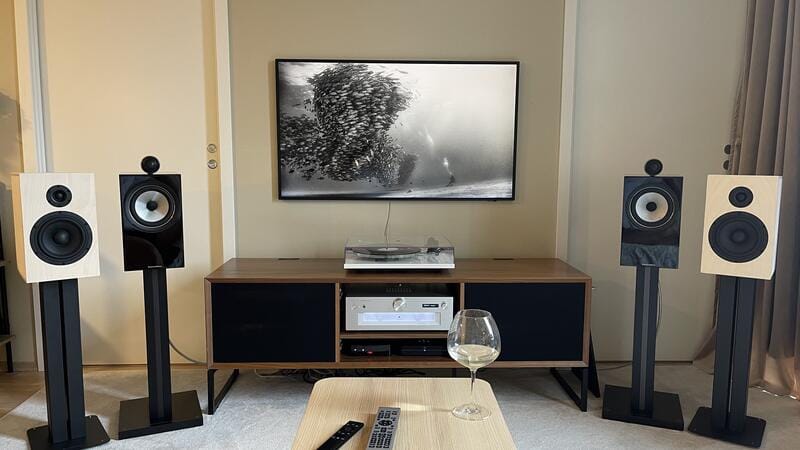
That story changed a bit when I put the Critons in the same positions as the Klipsch speakers have been.
I immediately noticed that the midrange and treble of the Criton 1TD-X was smooth and realistic sounding.
Much sweeter than the B&W 705S2 that I brought out of storage for some early comparisons.
But I also noticed that the bass sounded boomy and mushy. The energy (volume) in the bass seemed too high and the texture in the lower frequencies was just not there.
I discarded doing more critical listening with the CSS speakers in this position, I understood that this placement did not extract their potential. The bass was just too boomy.
I got out my miniDSP UMIK-1 measurement microphone and did a few frequency response measurements using the free REW software. To get a clearer picture of what’s going on.
Initial Measurements
Setup: Speakers about 1.5 feet from front wall, playing across my rectangular shaped room.
First, let me disclose that I am an amateur at acoustics measurements at best. So please use these measurements as guidance/entertainment only, they are not done by a professional!
Also, please note that these measurements only apply to my 21 x 11 feet room, and that measurements results will probably be different in any other room.
That said, when I did a few frequency sweeps with the mic placed in my listening position I immediately noticed what caused the bass to sound so boomy and rubbery.
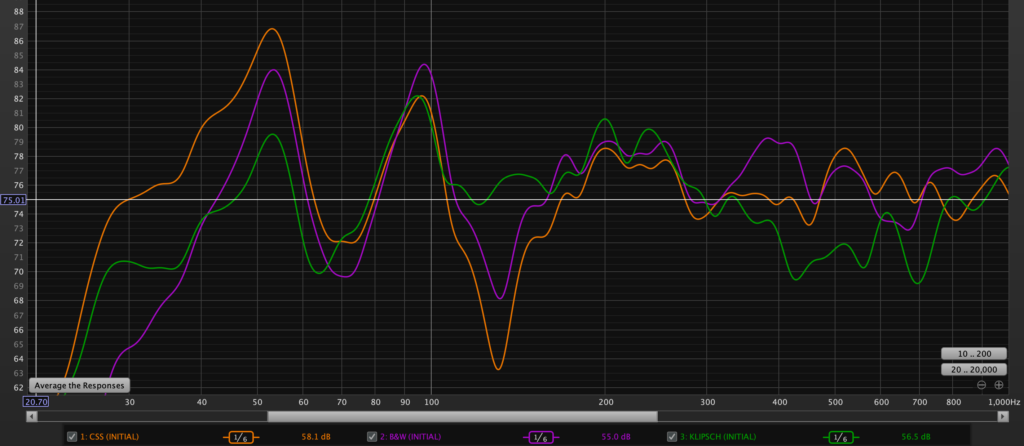
Wit the CSS Critons 1.5 feet from the long wall, my room had a 12dB peak at 50Hz measured in my listening position.
I also had a 12dB dip at 130Hz, and a noteworthy peak at about 100Hz.
Not a very flat curve to state it mildly…
For comparison, the Klipsch Heresy IVs did not have any peaks or dips bigger than 7dB playing from the exact same position. And that is probably within what’s sound ok to the human ear.
I have not used the B&Ws much in this room, but they also thrive a bit better than the Critons in this position, although noteworthy peaks and dips are present with the B&Ws as well.
The CSS Criton 1TD-X clearly pressurizes my room in a different way than my Klipsch and B&W speakers, putting out more low frequency energy that makes my room “misbehave” more than what’s acceptable at lower frequencies.
I assume this is not specific to the Criton 1TD-X but might be the case with any other speaker with decent bass output.
I then, almost by accident, opened the Room Sim tab in the REW software and entered my room dimensions into the simulator. The software then showed me a room sketch that recommended that the speakers play lengthwise in the room and that the front of the speakers should be about 4 feet away from the front wall, which is quite far out from the wall.
I rearranged all the furnitures in my room to play lengthwise in the room and positioned the CSS speakers exactly as suggested by the REW room sim software, 4 feet from the front wall.
With this configuration, I also got a lot more air around the listening position, my head is much further from the walls. Not cramped up against the back wall as it was before. This might be just as important as the distance between wall and speakers to avoid those pressure zones that cause low frequency peaks and dips.
Final Listening Test
Setup: Speakers about 4 feet from front wall, playing lengthwise in my rectangular shaped room.
In their new position, 4 feet from the from wall, playing lengthwise in my room, the CSS Criton 1TD-X immediately sounded amazing.
Boomy bass was not a problem any more and the soundstage become even bigger, especially in depth.
The bass transformed from boomy and rubbery to tight and textured.
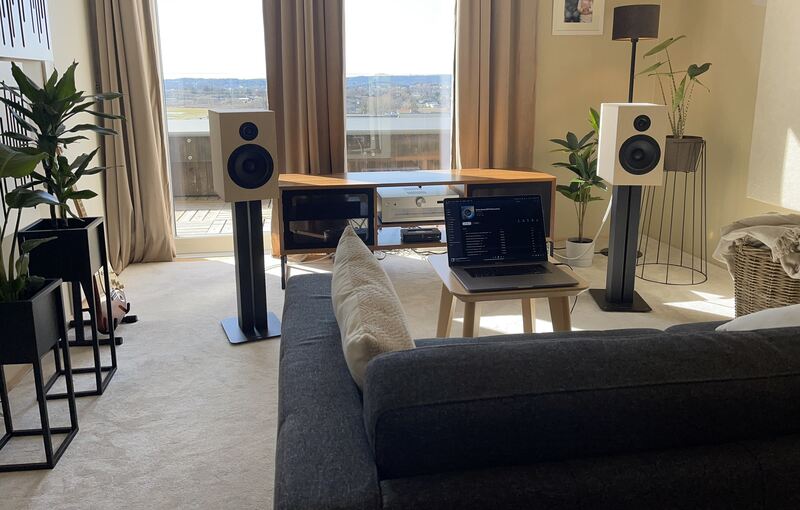
Roger Waters’ bass guitar that are so prominent on many tracks on ‘Pink Floyd The Wall’ sounds tight, engaging and powerful.
I assume this shows that the Critons low frequency output is on the top-end of what my room can handle. Making ideal speaker and listening position placement critical to obtain tight bass.
I wanted to test if the somewhat overwhelming bass groove on Alannah Myles’ ‘Black Velvet’ would stay tight and textured, and it did. No issues with boominess or loss of texture at all.
The Critons bass is tight and punchy without that somewhat ‘moody’ and ‘in your face’ attitude I get from the B&W705S2s in the bass and lower midrange. The Critons sound more natural and pleasant than B&W without compromising speed or dynamics.
What about midrange?
The midrange of the CSS Critons is simply amazing and might (or might just not) match the midrange performance of my Klipsch Heresy IV.
The Klipsch Heresy IV has many imperfections, but they are universally praised (and loved) for their open and magical sounding midrange. So, I did not expect the CSS speakers to give them a real run for their money in this frequency range.
But they actually do. This was surprising to me.
Acoustical guitars and vocals (both male and female) sounds very natural and pleasant on the Critons and at the same time tight and accurate.
When I listen to the acoustic tracks on the original Rolling Stones Stripped album, the guitars sounds amazingly real. The soundstage is also big and accurate, much more precise than with the Klipsch speakers.
One area where the Klipsch might have the CSS beaten is on female vocals, they sound even more open and fluid with the Klipsch. But they sound softer with CSS.
Right now I can’t really say if I prefer the CSS Criton or Klipsch Heresy for female vocals. I love them both. I call it a draw for now.
While being somewhat torn on female vocals between the Klipsch and CSS, I would say that I prefer the midrange of the CSS overall. Acoustic guitars seem to have more texture with the Critons.
What about treble?
In this frequency range, my top criteria is that it must not be fatiguing, but soft and easy on the ears.
I don’t even know if I have the ears and experience to distinguish great treble from decent treble, but I feel that the CSS speakers provide all the details and airiness I need, without being fatiguing. So perfect for me.
Personally, I believe the driver materials that reproduce the higher frequencies (a soft dome material in case of the CSS) are a more important factor for being non-fatiguing than a rolled off frequency response that is often presented as the main dominator for this by many YouTubers.
Even thought my B&W speakers show a more rolled-off top end than CSS in my measurements, the CSS feels far more pleasant and less fatiguing to listen too.
The Critons’ soundstage is big and precise and the instruments/artists are separated with well defined space between them. My B&W 705S2 speakers have never really let me down in this regard, but the CSS Critons seem to pin-point the instruments with more accurate and provide even more depth in the soundstage.
I guess this is where the superior crossover play its biggest role, providing that final level of accuracy to micro-details and micro-dynamics that paint an even more accurate soundstage with exceptional separation between instruments.
Overall, I am very satisfied with how the CSS Critons sound, they met my expectations in every possible way.
A tiny bit frustrating that they are so fuzzy about placement in my room but I guess that is what happens with speakers that put out sufficient low frequency energy (pressure) to test the limits of what the room can actually swallow.
Final Measurements
Setup: Speakers about 4 feet from front wall, playing lengthwise in my rectangular shaped room.
In their ideal position the Critons’ low-frequency response became much flatter. The 12dB dip at 130Hz is pretty much gone and the 50Hz peak is reduced from 12dB to 6dB.
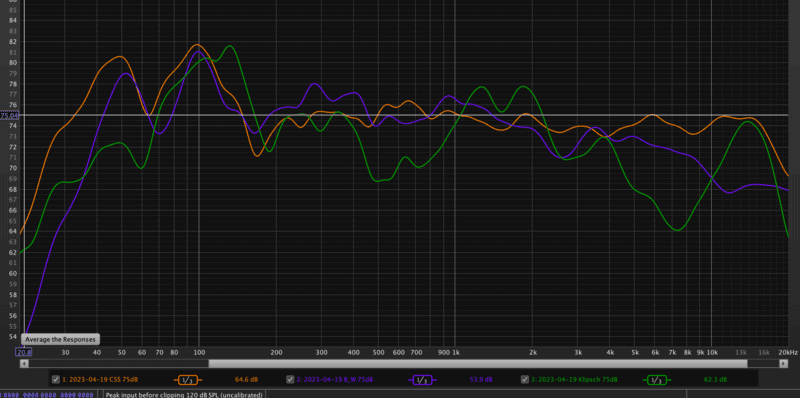
We can also see how the Critons play much deeper than the two other speakers.
I measure 3dB drop in bass at these frequencies:
CSS Criton 1TD-X: 26Hz
B&W 705S2: 38Hz
Klipsch Heresy IV: 42Hz
No need for a sub with the CSS Critons in my room. For sure.
We can also see in the measurement that the B&W 705S2 has a much more rolled-off high-frequency response than the CSS Criton 1TD-X. But does not sound nearly as sweet and pleasant in my ears. So sweet and non-fatiguing sound is definitely not all about the frequency response.
The CSS Criton 1TD-X also shows a very flat frequency response, save for below 200Hz where it is enhanced in my room, but that is likely caused by low-frequency room modes and has little to with the speakers. I would guess they play very flat in a bigger room.
Also, note the rollercoaster-like frequency response of the Klipsch Heresy IV. But they still sound delicious. Frequency response is not everything…
A Word on Speaker Sensitivity
One thing I have not mentioned so far is that the CSS critons need quite a bit more power from my amplifier to play at the same listening level as my B&W 705S2s.
I need to turn the volume knob a fair bit more with the CSS Critons.
When doing the measurements, I made sure to adjust the volume so that I measured all speakers at exactly 75dB in the listening position.
The numbers below show what volume level my amplifier displayed when the speakers played at 75 dB.
CSS: -31dB
B&W: -36dB
Klipsch: -45dB
(Please note that the numbers are negative so higher number means less power outputted by the amp.)
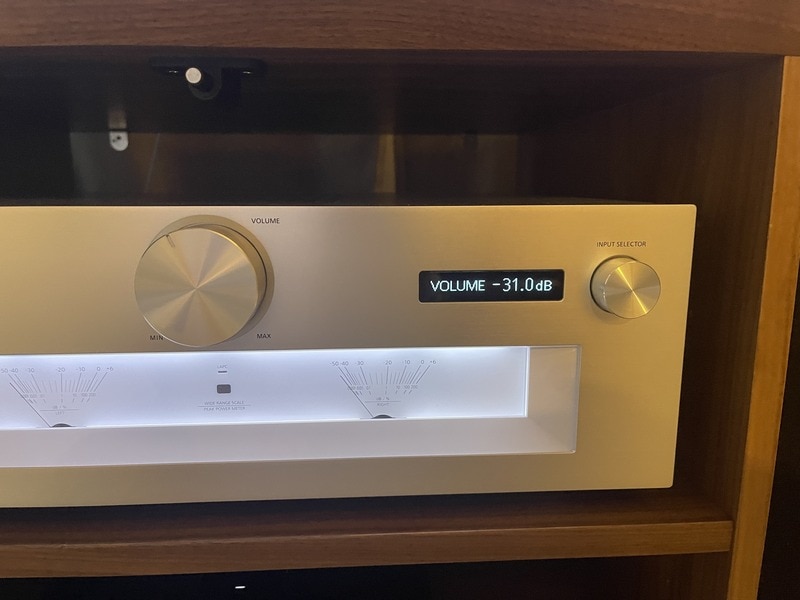
So, the CSS needed 5dB higher output than the B&W 705S2 to play at the same volume.
My B&W 705S2 have 88dB sensitivity, so this might indicate that the actual sensitivity for the CSS Critons is around 83dB, given that the dB number displayed on my amplifier is fairly accurate.
I have also seen other reviewers mention that the actual sensitivity might be a bit lower than the 87dB that is specified by CSS.
I don’t think this necessarily means that the CSS Critons are super difficult to drive, but they definitely need a few watts to play at decent listening volumes.
(Yes, the Klipsch Heresy IVs have very high sensitivity, around 98dB in room.)
Conclusion
I cannot say if the CSS Criton 1TD-X perform at nearly the same high-end level as Dynaudio Heritage Special and Sonus Faber Electa Amator as suggested in the intro.
I have no clue, I have not compared with those speakers.
But I can definitely say that they reproduce music with great details, great realism, great dynamics and great soundstage without being harsh or fatiguing.
And that is everything I want from my speakers for now.
I am overall very pleased with how this experiment turned out and how my new CSS speakers sound.
I would, ideally, like them to be a tiny bit leaner in the bass department to make them easier to integrate with my room, but I managed to find a position where they integrate quite well so this is not the end of the world.
If you are ok with building your own speakers, I think you should give the CSS Audio Criton TD1-X kit serious consideration.
Thank you for reading, I hope this review provided value.